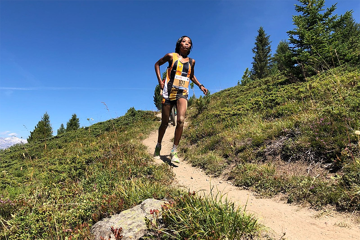Lucy Murigi wins the IAAF/WMRA World Mountain Running Championships (© Federació andorrana d’atletisme)
Any major sporting event requires months of preparation, but organising the World Mountain Running Championships presents a rather unique set of challenges.
The Argentinean town of Villa la Angostura will play host to this year’s World Mountain Running Championships in November and it will be the first time the global event has been staged in South America. Sixteen different countries have hosted the event over the past 34 years and the World Mountain Running Association (WMRA) has learnt a lot during that time.
Before any planning can begin, a robust budget is needed. A local organising committee (LOC) must have the financial ability to stage a championship event (roughly $300-$400,000) and the support of its national athletics federation.
Having a good course is a top priority, naturally, but not all venues will be able to fulfil the criteria. There are two types of courses in the World Mountain Running Championships – one is an uphill-only route (held in even-numbered years), while the other is an up/down loop course (staged in odd-numbered years).
Some venues have had to be creative with their courses. In Casette di Massa, Italy, in 2014, the start area was in a village with narrow streets, which led to a bottleneck at several key junctures until the athletes spread themselves out on the course, but it meant that the runners started with a sprint to guarantee a good position early on.
On that same course, there was a unique feature – a marble quarry – with athletes running through a tunnelled section to reach the summit; an amazing experience for all.
Likewise, the finish area requires planning. In Innsbruck in 2002, the men’s race finished in a mountain meadow, but it was used by cows in the weeks leading up to the race. Heavy rain poured down throughout the day and washed rivulets of cow manure throughout the finish area, making a rather unpleasant surface for fans and spectators to stand in. The athletes weren’t too concerned as mud and manure are sometimes a part of any mountain race, but their changing gear bags were also in the path of this unwelcome stream.
The WMRA always has a difficult task in determining the best host for their championships. Often a bid will be well funded with excellent organisation but if the course doesn’t fit into the parameters for enough steep hill running then it’s just not possible to accept it.
The majority of venues suitable for hosting a World Mountain Running Championship are often in small mountain villages with the nearest airport about three or four hours away, so the requirements for bus/van/train transportation must be factored into the budget.
Once at the venue, the accommodation may be far from the course and require additional transportation getting athletes to meal functions and to the course for training and on race day. Ski lifts are sometimes required to access the course.
For races that finish at the summit of a mountain, transportation back down the mountain will be needed. But sometimes there may not be a road to the summit, and even if there is, the logistics at a finish line may not accommodate spectators, as was the case in Casette di Massa where the arrival point was inside a working quarry and safety rules made it difficult to bring anything other than a four-wheel-drive vehicle to the top.
When races are held near a ski area, a gondola or funicular may be the best way off the mountain, but there may be a limit to the number of people each car can hold. In Innsbruck in 2002 a long line of people had to wait for their return trip to the start line. This, combined with the heavy rain, meant that people had to huddle close together inside the gondola station. Thankfully spirits were kept high by the bar inside serving local beer and schnapps.
When Andorra hosted the championships in 2018, organisers limited the number of people at the summit finish line as the weather forecast called for frosty and winter-like conditions and the only way off the mountain was an open-aired chair lift.
The 2006 edition in Bursa, Turkey, was another example of an event with challenging access. Unusually, the team hotel for this championship was at the highest point on the course, so before the start athletes and supporters would take the cable car down, but strong winds made it a rough ride and there were some queasy looking people stepping off it.
Weather can also wreak havoc on an event, especially changing conditions so often experienced in mountainous areas. What may start out as a sunny day may turn to treacherous conditions in an hour’s time, so an LOC must have plans in place to ensure the safety of runners in the case of bad weather. This may also require provision for an alternate course.
In 2003, the Alaskan town of Girdwood hosted the championships. Given the location being near the Arctic Circle, the LOC was asked during the bidding process about the possibility of snow. “It’s never ever snowed here at that time of year,” they said.
But between the first and second days of the championships, snow fell overnight and accumulated on course from start to finish. Decisions had to be made for the safety of the runners and the start had to be delayed to clear some areas of the course and ensure additional volunteers and support staff were positioned on the course.
The WMRA works hard to have events in many different parts of the world to ensure it has truly international championships. But communication across different languages can sometimes throw up unusual situations.
La Reunion hosted the races in 1998 and even though the course had been checked and approved by the WMRA technical delegate earlier in the year, when the runners arrived they found that the organisers had added a new loop into the men’s event. The additional three kilometres made it the longest ever classic distance World Mountain Running Championships.
“Mountain running is a great spectacle and challenge for everyone involved,” says WMRA President Jonathan Wyatt. “But because we work in the mountains, we enjoy coming up with solutions to the unique problems that we face.”
Nancy Hobbs and Jonathan Wyatt (WMRA) for the IAAF







